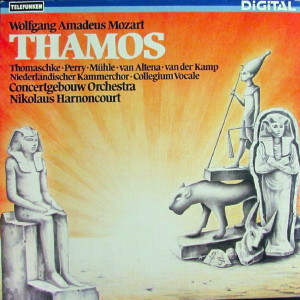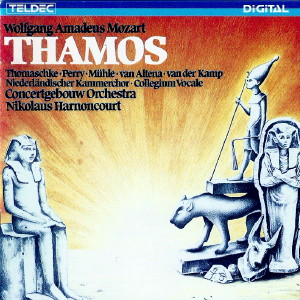 |
1 LP -
6.42702 AZ - (p) 1981
|
 |
| 1 CD -
8.42702 ZK - (c) 1984 |
|
| Wolfgang Amadeus
Mozart (1756-1791) |
|
|
|
|
|
|
|
| Thamos, König in Ägypten,
KV 345 (336a) |
|
|
|
| - Nr. 1 - Erster Aufzug:
Maestoso "Schon weichet die Sonne" |
6' 21" |
|
A1 |
| - Nr.
2 - Zweiter Aufzug: Maestoso - Allegro |
5' 25" |
|
A2 |
| - Nr. 3 - Dritter Aufzug:
Andante |
4' 24" |
|
A3 |
| - Nr. 4 - Vierter Aufzug:
Allegro - Allegretto - Andante - Più
Andate - Più Adagio - Allegretto - Adagio
(Melodram) |
4' 27" |
|
A4 |
| - Nr.
5 - Vierter Aufzug: Allegro vivace assai |
3' 37" |
|
B1 |
| - Nr. 6 - Fünfter Aufzug:
Adagio maestoso "Gottheit, über alle
machtig!" |
10' 15" |
|
B2 |
- Nr. 7: Andate moderato "Ihr
Kinder des Staubes"
|
8' 15" |
|
B3 |
|
|
|
|
| Thomas
Thomaschke, Baß
(Oberpriester Sethos) |
|
| Janet
Perry, Sopran |
|
| Anne-Marie
Mühle, Mezzosopran |
|
| Marius
van Altena, Tenor |
|
| Harry
van der Kamp, Baß |
|
|
|
| Niederländischer
Kammerchor / Kerry Woodward, Leitung |
|
| Collegium
Vocale / Philippe Herreweghe,
Leitung |
|
| CONCERTGEBOUW
ORCHESTRA, AMSTERDAM |
|
|
|
| Nikolaus
Harnoncourt, Gesamtleitung |
|
|
Luogo
e data di registrazione
|
Concertgebouw,
Amsterdam (Olanda) - novembre 1980
|
|
Registrazione
live / studio
|
| studio |
Producer
/ Engineer
|
-
|
Prima Edizione CD
|
| Teldec
- 8.42702 AZ - (1 cd) - 42' 44" - (c)
1984 - DDD |
Prima
Edizione LP
|
Telefunken - 6.42702
AZ - (1 lp) - 42'
44"
- (p) 1981 - Digital
|
|
|
Notes
|
The music for the
heroic drama “Thamos. King in Egypt”
by Tobias Freiherr von Gebler
(l726-1786) is Mozart`s
only work of incidental music. The
play was published in 1773 in Prague
and Dresden and performed on 4th April
1774 at the Kärntnertortheater
in Vienna. Gebler was a poet, Imperial
counsellor and Vice-Chancellor of the
Royal Bohemian Chancellery; he had
originally commissioned music for two
choral scenes from a certain Johann
Tobias Sattler. On 31st May 1773
Gebler wrote to Christoph Friedrich
Nicolai in Berlin: “lf my Thamos
should be so honoured as to be
performed in Berlin, I can provide
some choral music which is not at all
badly written and has been supervised
throughout by Gluck.“ But evidently
Gebler was not satisfied with
Sattler’s composition, since on 13th
December 1773 he announced: “Anyway
,... I enclose the music for Thamos,
as it was set recently by a certain
Sigr. Mozzart. It is his original work
and the first chorus is very fine.“
One may conclude from the fact that
Gebler refers to "a certain Mozzart“
that the young artist was a fairly
unknown composer, as far as the author
was concerned.
Mozart probably wrote out the two
choruses at the opening of Acts 1 and
5 in the autumn of 1773. It was a
well-established Viennese tradition to
play music in the intervals between
the acts of spoken plays, and also to
provide a musical introduction at the
beginning of the performance. Opinions
differ about the date of the
entr’actes: some experts take the view
that the two choruses were written in
1773 and the entr’actes in 1779/80;
others argue that the entr’actes were
also composed in 1773 and merely
revised in 1779.
As is apparent from the Salzburger
Theaterwochenblatt, a weekly magazine
giving information about the theatre
in Salzburg, of 3rd January 1776, the
great chorus scene No. 7 does not date
from 1779, but had already been
performed in Salzburg in 1775. This
performance in Salzburg leads one to
assume that Mozart’s entr’acte music
was also played. Johann Böhm,
who made guest appearances with his
troupe in March of April 1779 and
again from September until March 1780,
used Mozart’s music for “Lanassa“, a
play by Karl Martin Plümicke,
set in India, a German version of
Antoine-Marin
Lemierre’s tragedy “La veuve du
Malabar“.
Mozart thought very highly of his
“Thamos“ music. On 15th February 1783
he wrote to his father in Salzburg: “I
am truly sorry that I shall not be
able to make use of the music for
Thamos. This play has been discarded
here, because it was not liked, and
will not be performed again. It ought
to be performed, just for the sake of
the music.“ The ideas of enlightenment
and freemasonry and the fact that it
is set in Egypt have made “Thamos“ the
prototype of the “Magic Flute“.
Rudolf Angermüller
Translation:
Lindsay Craig
|
|
Nikolaus
Harnoncourt (1929-2016)
|

|

|
|